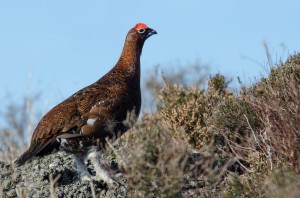
Game and Wildlife Conservation Trust scientists have published a paper which says that ‘Respiratory cryptosporidiosis is a new and rapidly spreading disease in red grouse.’. This is a disease normally found in captive birds but the first case in the ‘wild’ was found in the North Pennines in 2010. Worryingly, this paper also states that there is evidence that the disease has spread to Black Grouse too.
The protozoan responsible, Cryptosporidium baileyi is normally found in poultry and is not thought to be infectious to humans (unlike other Cryptosporidium species).
The disease does appear to be spreading and it seems to have its highest incidence in the North Pennines at the moment – though the first Scottish case was recorded in 2013 in the Lammermuirs (how did it get there?).
As the authors say, driven grouse shooting, which involves flushing birds out of their territories and towards waiting guns, is a way of mixing up birds and potentially increasing transmission rates of diseases. Cryptosporidium is now added to the potentially important diseases of Red Grouse alongside strongylosis (caused by infection from a parasitic worm) and louping ill ( a viral disease transmitted by ticks).
One has to wonder, doesn’t one, whether the unnaturally high densities of Red Grouse which are necessary for driven grouse shooting to be economically viable (in the bizarre world of this ‘field’ ‘sport’) are a reason for the incidence of disease? If only there were a few predators to take out the sick individuals as would happen in natural populations….
It makes you wonder whether the average Red Grouse wouldn’t vote for a ban to driven grouse shooting.
[registration_form]
You can’t really say much more can you? Yet again human ignorance proves detrimental to nature.
Am sure GWCT and BASC and the Moorland Association and all the other pro-shooting lobby will point to the consequential economic benefits of this new disease. More jobs in the pharmaceutical industry to develop a drug, more jobs for gamekeepers to administer the new drug, more jobs in the supporting industry (bucket manufacturers) to carry the new drug from shop to moor….
So all in all, very good news.
On the other hand…
Imported, disease ridden pheasants and red-legs are released where the range overlaps with black grouse and occasionally red-grouse. Combine this with the un-natural high densities in the grouse population and simplified habitat….. perfect storm situation.
Quite – I gather pheasants and red legged partridge are imported by the million. No wonder our overstocked grouse moors have an obvious problem, which will no doubt (as mentioned) hit black grouse and probably our own grey partridge too!
We seem to have opened a Pandora’s Box – biosecurity has been and is still, so lax in this country it borders on being criminally irresponsible. There are now so many alien ‘things’ in this country attacking our native wildlife I think we should be very worried for the long term viability of our ecosystems. Free markets, the EU idea of no borders and globalisation are destroying our little bit of wonderful land.
Poor Red Grouse. If the virus transfers to Black Grouse perhaps there is a stronger case for banning grouse shooting.
Before continuing to beat the “Biosecurity Drum”, how about considering how much you would enjoy life without potatoes, maize, all trees except Scots Pine and Pedunculate Oak etc. — and rubber tyres for your car?
All are the result of deliberate introductions. Kew Gardens was set up in George II’s reign to spread ‘useful’ plant species across the British Empire and the world. Consider how the world’s agriculture would look, if “Biosecurity” had been the watchword then. I suspect that half of us what not be here – because a world of bio-isolated islands would not support 6 billion humans . . . . .
Giles – welcome and thank you for your comment, though you seem to have missed the point. I don’t talk about introductions at all. Would you like to comment on unnaturally high Red Grouse densities as a contributor to disease transmission?
I was told on good authority a few weeks ago that one of the major estates in the Nidderdale AONB ( my local patch) has cancelled all shooting of red grouse, pheasants and partridges because of this disease— known to many as bulgy eye.
A disease of domestic fowls including redlegs and pheasants now passed to native gamebirds, another damaging act by the shooting industry to native ecology, how many more before it’s properly supervised? Whilst wouldn’t wish this on any NATIVE bird there is some irony here as said estate is one of the most notorious in terms of poor ( intensive) management and raptor control. I nearly, I did say nearly, rang them and congratulated them on greed coming back to bite them in the arse!
I also understand that all the vetmeds to combat this disease are unlicenced for use in grouse.
Wonder if they’ll find a way of blaming the disease spread on some wild native animal, not that there’s much left on the grouse moors except for Grouse. Those poor Curlews that they keep bleeting on about will be in trouble if there’s any hint that they could transmit the disease…
AS we all know that the disease is spread by especially Red legged Partridge why has the Game conservancy not come out to add a 5 – 10 mile radius where Pheasants and RLP can not be introduced close to Black and Red Grouse moors? I feel another petition coming on especially as the rare Black Grouse are really struggling on moors managed for only Red Grouse and contributed large amounts to eco tourism.